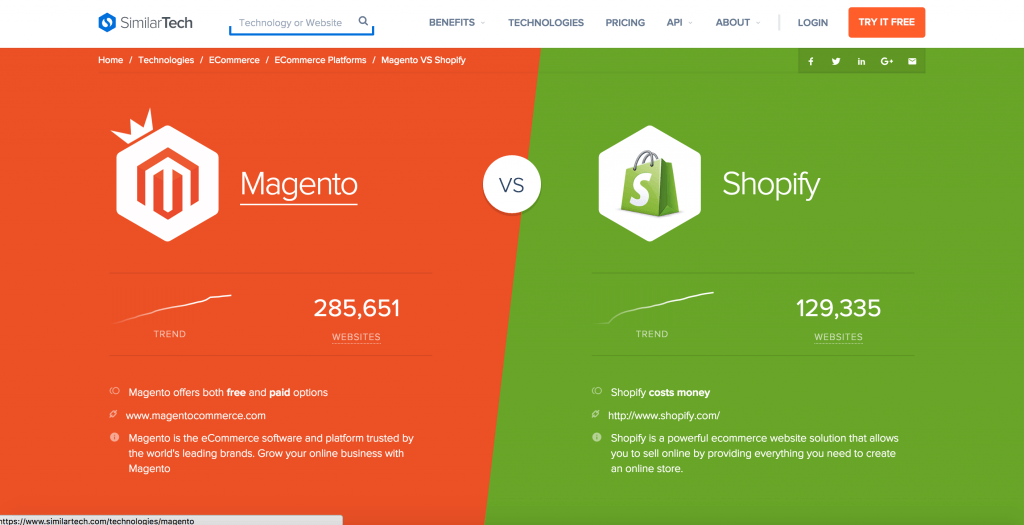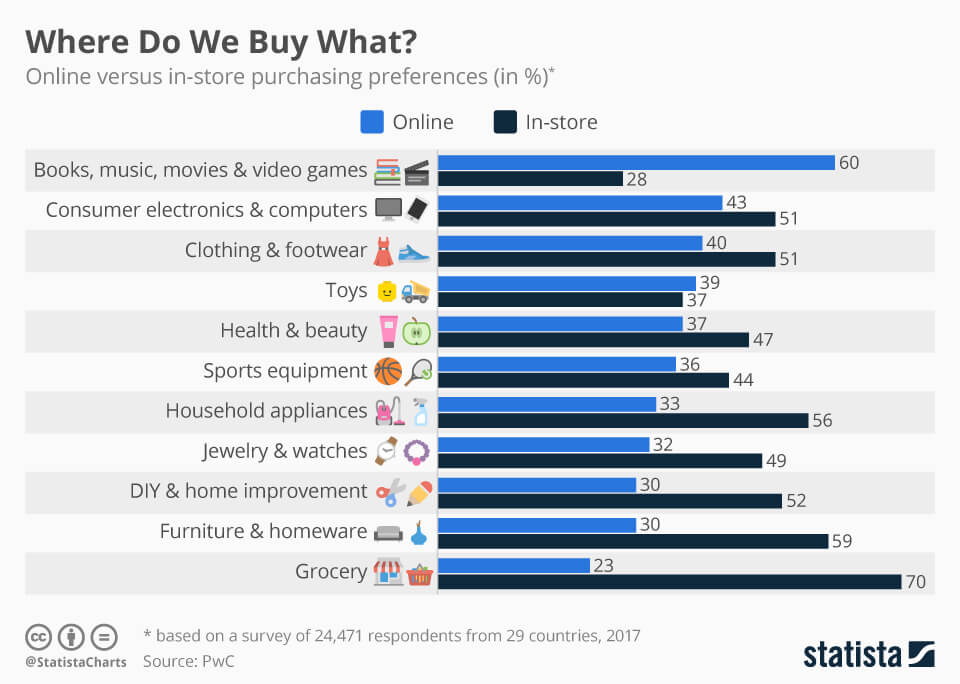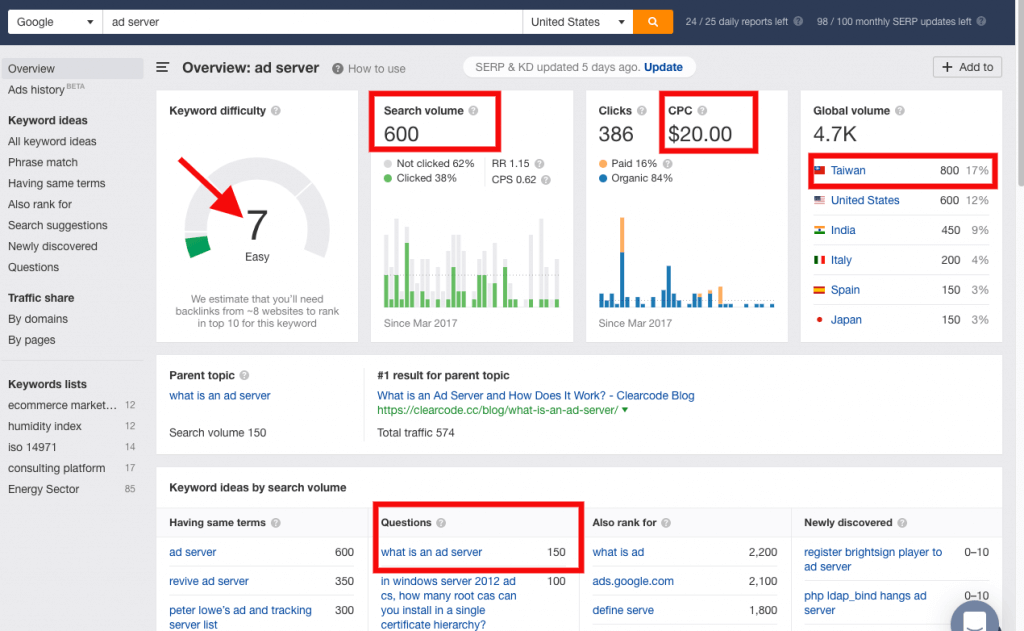As you drink that fourth cup of ☕ for the day to recover from the data overload of part 1, and take a deep breath before you venture into part 2, let me reassure you, part 2 of The Hustler’s Guide to Market Research on a Shoestring Budget is like most sequels – you can ⏩ through it if you like and still get the gist of it. Not knocking myself down, just telling it like it is.
If part one is designed to provide you with a methodology to perform the type of market research that actually means something, then part two is about providing you the tools you need to fill in the blanks with data on your industry and competitors.
Solutions like “BuiltWith”, “Datanyze” or “SimilarTech” can come in very handy when doing market research.
So let’s get our hands dirty by using the AdTech SaaS example from part 1:
“consider we wanted to launch an ad server designed only for digital publishers. Anyone can find figures on the size of the AdTech industry but how do we estimate the size of the AdTech market on the publisher side alone?”
Using either BuiltWith, Datanyze, SimilarTech or similar solutions, you can get a good estimate of the size of your industry. For example, almost every digital publisher monetizes with ads. You can’t monetize with ads without partnering with Google. Therefore, almost every digital publisher will deploy the Google Publisher Tag (GPT) in their source code. You simply need to answer:
What percentage of websites have the Google Publisher Tag?
Just ask Datanyze. Granted, this isn’t the most accurate method but you can do it in 15 minutes and it won’t cost you a thing.
However, not all industries are of a high profile like AdTech, and provide a client side implementation, which solutions like Datanyze can track.
If you’re in an industry that doesn’t deploy SaaS solutions through Javascript then there are other options to fast track or outsource your research.
Upwork freelancers
Upwork is a freelancer marketplace. You can find highly experienced professionals on a very wide variety of tasks. One of those tasks is market research. Remember to be very specific with your requirements. In fact, if you don’t know exactly what you need or you can’t put it into specific terms, that’s a good indication it is too early to hire an Upwork freelancer.
First, get your ? in a row, understand exactly what you need and what you expect the deliverable to be, and then contract an Upwork pro and you can expect good results. If it helps, you can imagine you’re hiring someone for a specific in-house position. Then, write out the job requirements for this imaginary position. This should get you safely on the road to a successful Upwork project that doesn’t have you pulling your own hair out wishing you’d done it yourself instead.
Finally, to the meat and potatoes. Here are some tools that will help you generate that market research report you’ve been craving for. By the way, I’ve personally used each one:
Top 8 Market Research Tools for Entrepreneurs
1. Google Trends
The best things in life are free, at least according to Janet Jackson, and, Google Trends is pretty nice free solution for market research. Understanding if the solution you provide, the industry you plan to service or the audience you would like to target is big enough or even exists is, undoubtedly, a good place to start your research.
When you use Google Trends, think about what your target audience would be searching for to find you or your competitors. You may already be thinking, I can already do that with pretty much any keyword research tool. Where Google Trends is useful is, predictably, in observing trends for particular keywords and topics.
Google Trends can demonstrate if a particular solution, industry or audience is expanding or extracting. For example, I ran a topic comparison for two back-end programming languages: Java and Python over the last 5 years:
If you’re a developer reading this then the rise of Python is not something that would likely knock you off your chair. However, if you have even the most modest business acumen, then you realize this graph is displaying one thing: an opportunity.
This simple graph can act as the launching point for your next startup. For example, when I was in school, one of my academic advisors told me all research projects start by someone asking “Why”?
So let’s try that. “Why is Java decreasing in search popularity”? “Why is Python on the rise”? You may discover that Java is a resource heavy language. One that requires a lot of time to learn, is less agile, and difficult to maintain software written in it. However, considering Java has been one of the most popular coding languages for over a decade, there is obviously Java software out there. What if you could develop software that solves for the problems Java creates. In a way this is the premise behind Kotlin, the language now used by most Android developers.
2. Datanyze Insider (Free)
Like many other solutions on this list, Datanyze’s market research tool leverages their own user data. Datanyze offers a free browser extension, and as the saying goes, “if it’s free, you’re the product”.
When you use your browser to access a website, the Datanyze browser extension “listens” in on server requests made by the website to other web domains. It uses those “network requests” to analyze the third party software used on a website and then provides that information free of charge. The more users the free extension has the more they can cross-reference data across various web sessions for a single website and get accurate results.
Since the Datanyze extension has data from over 50K active users it has likely scanned millions of websites and has aggregated this data into its database. This allows Datanyze to create industry reports. For example, it could tell you how many eCommerce websites in the US use Woocommerce.
Tools like Datanyze are called Technographic search tools. You can also use their free Technographic Analysis to uncover the tech used by your choice of companies.
Or, you can just cut to the chase and pick up one of their market share reports.
Recently, Datanyze was acquired by Zoominfo. This is especially interesting when prospecting for customers. However, for the purposes of market research this likely has little impact.
Pricing: Free with limited features and functionality. Paid plans start at $600 / month.
2. BuiltWith
BuiltWith is another technographic solution, very similar to Datanyze. Back in 2014, BuiltWith was leading the pack. However, the market research extension industry has pivoted towards data enrichment and prospecting for sales teams leaving BuiltWith a bit behind in its offering.
For technographic research accuracy, BuiltWith’s browser extension has 5 times as many users as Datanyze. This is just my assumption, but their users are likely more technical in orientation than Datanyze’s.
If you’re looking at doing research on stuff like JavaScript libraries, Dev Frameworks, CSS Media Queries, etc. then BuiltWith would be a better solution than Datanyze.
Useful tools:
- Technology Investor – as the name implies this is an index of web technologies separated by categories with their growth (or contraction) over the last 10 months across the top 1 million websites. Keep in mind, this means you will mostly find here AdTech and MarTech solutions for enterprises. If this is your target audience then great but if not this solution is not for you.
- Trends – BuiltWith’s Trends provides the number of websites using a particular solution. Unlike the tech investor tool this tool doesn’t only monitor the opt 1 million so if you’re not targeting large web brands then this solution is more your speed.
- Website List – A list of websites per category (fashion, software, travel, hotel, etc.). I love this tool! It helps you ballpark the market size by better understanding the number of websites/companies that could be your potential customers and also provides an estimate of tech spend for each. Then, you can download it all into a spreadsheet and Data Dan’s your uncle you got yourself a market size estimate.
Pricing: Free version and paid plans start at $295 / month which includes 2 reports, 2 keywords, and 2 technologies / month.
3. SimilarTech

Backed by SimilarWeb, SimilarTech is another technographic tool based on data fetched from a proprietary browser extension. However, SimilarWeb’s half a million users for its extension is by far the most out of any of the products listed here. So, conceivably their data would be more accurate and up to date.
You can quickly find out if SimilarTech has info on your industry and competitors by accessing their web technologies index (very similar to BuiltWith too :)). Like Datanyze, Similar Tech is more geared for data enrichment for sales teams. However, ultimately, as an entrepreneur, your market research goals are not that different from that of a sales manager. You want to better understand the market size and your penetration opportunities.
Pricing: Free version is available. Paid plans start at $290 / month which includes 10 reports, 1,000 websites per report, 50 email addresses of prospects, and more.
4. Statista

Unlike the above solutions, Statista is more of a pure market research solution. It claims to cover over 600 industries across over 50 countries. I like this solution for market research because it gives you exactly what you need without too much fuss. You can get information on overall industry revenue, valuation of industry leaders, etc.Their detailed and fully compiled industry reports are over $1K each but you can opt for their $49 / month premium account and build your own.
Tip: When using solutions like Datanyze, SimilarTech, BuiltWith, etc. to research a specific company’s tech stack use their browser extensions to examine their web app domain (app.domain.com) not just their marketing website (domain.com). Otherwise, you will mostly get marketing and advertising technology results.
5. Israel Export Institute
Mailto: information@export.gov.il
For the Israelis readers in the crowd, the Israel Export Institute, IEI, offers a free market research service. Keep in mind, as great as the IEI are, and they are great, it’s still a government agency and this is still a free service so make sure to adjust your expectations. Bonus: with the market research service comes pay-as-you-go access to Discover.org billed at 10 NIS (about $3.5) per contact.
6. Ahrefs
Moving away from technographics but staying on point. Google, in 2020, is still the gateway to the internet, and I can’t see that going away anytime soon. That makes search engine research tools, like Ahrefs, particularly effective market research tools. For example, let’s go back to my Ad Server example from part 1 of this guide. If we plugin in the search phrase “ad server” into Ahrefs this is what we get:

The search phrase “ad server” has over 4,700 searches a month worldwide. With Taiwan leading the way. It doesn’t end with search volume though. If I were to run an ad in Google ads, Ahrefs provides average Cost Per Click for the keyword “ad server” ($20.00 on average, by the way).
If I aspire to have a 5% conversion rate on my “Request a Demo” homepage, I now know that acquiring a lead through Google ads for my SaaS ad server will cost an average of $400 per lead.
With Ahrefs, I can determine my target audience, competitors, and pricing. In addition, I also have the data I need to understand how hard it will be to rank for organic keywords in Google.
Bottom line, I really like Ahrefs for market research because it is comfortable to use, it’s fast, is more accurate than others I have used, and has great additional features like domain tracking. Is it a must have for market research? Probably not, Spyfu, which is free, could be good enough, but I can only recommend what I have actually used ?.
7. Quora

Speaking of search engines, Quora, the Q&A search engine is frequented by over 300 million monthly visitors, which makes it one of the most popular search engines in the world. Quora is extremely popular with B2B audiences too and quora’s advertising platform is becoming mostly b2b.
The reason Quora is attracting B2B advertisers is because much of the queries on Quora are B2B in nature. There is even a topic dedicated to market research with over 880K followers.
Best of all, Quora is a free resource while, at the same, fully customized to your needs. Simply ask a question and (hopefully) you get a valuable answer.
8. Facebook Groups

If there is an industry there is a FB group for it. Trust me. In fact, there’s a good chance you discovered this article in one of your Facebook groups ?.
A great way to gain information about your target audience and market is to join in the conversation. Don’t be spammy. Be engaging and be honest. Explain what you’re trying to accomplish and ask for peoples’ help. You’d be surprised at the response rate you can achieve with a simple and honest request.
I can personally recommend the following groups for SaaS and B2B entrepreneurs:
Product-Market-Fit is a Journey and Other Cliches
First, I’d like to apologize for taking so long to write part 2. By now, you’re probably already managing a successful startup with thousands of paying customers so you don’t really need this anymore. In that case, did I mention I also do lead generation and marketing automation ?.
But seriously, just walk by any coffee table in Silicon Valley (unless if you’re reading this during the COVid pandemic) and you’ll hear an average of at least 5 startup cliches per minute. However, though most of those cliches are worth ignoring there is one that isn’t: “product-market-fit is a journey not a destination”. You’re never too big or too experienced to do the research.
The market changes, your product changes, your pricing changes, and all of these impact your PMF so save this article (and Part 1, which if you haven’t read yet you should read now) and share it with your network ?.

The Founder & Chief Getting Sh%T Done Officer of mvpGrow. After about 8 years as a hired hand some of the largest (and smallest) B2B SaaS companies worldwide I decided to hang up my employee slippers and lace up my growth agency cleats. But just because I’m an agency doesn’t mean we can’t chat (no charge). Please email me on any topic and I will gladly reply: eyal@mvpgrow.com

